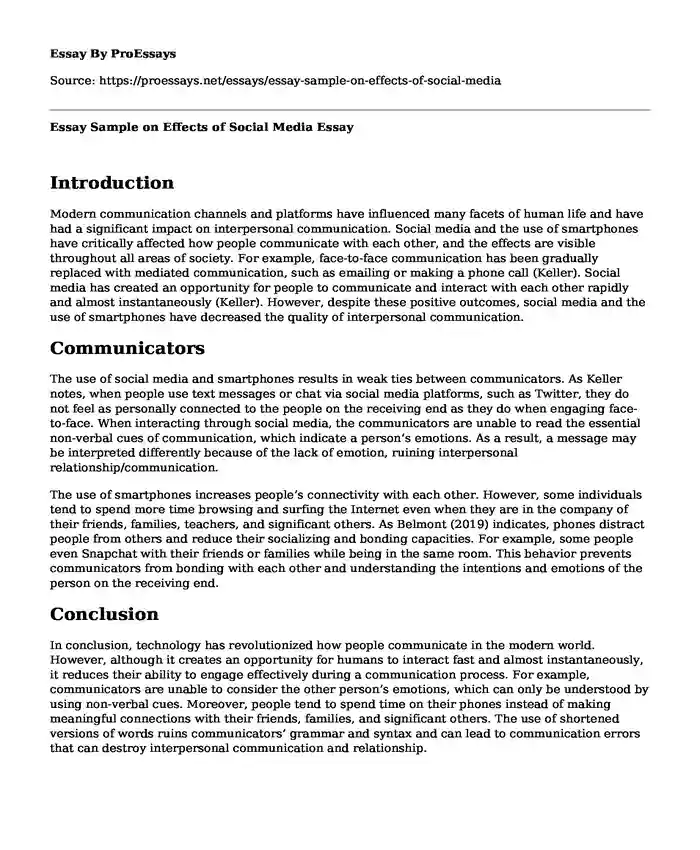Introduction
Modern communication channels and platforms have influenced many facets of human life and have had a significant impact on interpersonal communication. Social media and the use of smartphones have critically affected how people communicate with each other, and the effects are visible throughout all areas of society. For example, face-to-face communication has been gradually replaced with mediated communication, such as emailing or making a phone call (Keller). Social media has created an opportunity for people to communicate and interact with each other rapidly and almost instantaneously (Keller). However, despite these positive outcomes, social media and the use of smartphones have decreased the quality of interpersonal communication.
Communicators
The use of social media and smartphones results in weak ties between communicators. As Keller notes, when people use text messages or chat via social media platforms, such as Twitter, they do not feel as personally connected to the people on the receiving end as they do when engaging face-to-face. When interacting through social media, the communicators are unable to read the essential non-verbal cues of communication, which indicate a person’s emotions. As a result, a message may be interpreted differently because of the lack of emotion, ruining interpersonal relationship/communication.
The use of smartphones increases people’s connectivity with each other. However, some individuals tend to spend more time browsing and surfing the Internet even when they are in the company of their friends, families, teachers, and significant others. As Belmont (2019) indicates, phones distract people from others and reduce their socializing and bonding capacities. For example, some people even Snapchat with their friends or families while being in the same room. This behavior prevents communicators from bonding with each other and understanding the intentions and emotions of the person on the receiving end.
Conclusion
In conclusion, technology has revolutionized how people communicate in the modern world. However, although it creates an opportunity for humans to interact fast and almost instantaneously, it reduces their ability to engage effectively during a communication process. For example, communicators are unable to consider the other person’s emotions, which can only be understood by using non-verbal cues. Moreover, people tend to spend time on their phones instead of making meaningful connections with their friends, families, and significant others. The use of shortened versions of words ruins communicators’ grammar and syntax and can lead to communication errors that can destroy interpersonal communication and relationship.
Works Cited
Belmont, R. “The Effects of Social Media on Social Skills.” Horizon Online, 7 Jan. 2019,
https://lhshorizon.com/2828/opinions/the-effect-of-social-media-on-social-skills/.
Bhamare, C. R. “Effects of Social Media on Communication Skills.” Knowledge Review, https://theknowledgereview.com/effects-social-media-communication-skills/.
“How Technology Affects Social Skills.” Liberty Classical Academy,
https://libertyclassicalacademy.org/technology-affects-social-skills/.
Keller, M. “Social Media and Interpersonal Communication.” Social Work Today, June 2013,
https://www.socialworktoday.com/archive/051313p10.shtml. Accessed 21 Sept. 2020.
Cite this page
Essay Sample on Effects of Social Media . (2023, Dec 10). Retrieved from https://proessays.net/essays/essay-sample-on-effects-of-social-media
If you are the original author of this essay and no longer wish to have it published on the ProEssays website, please click below to request its removal:
- Love Just a Coincidence - Movie Description Example
- How to Be a Top Selling Writer? - Essay Sample
- Contributions of Lumiere Brothers to Modern Film and Photography
- Essay Sample on Women and Race
- Paper Example on Exploring Representation of LGBTQ Community in Arab Cinema
- Essay Example on Friendship Conflict: Resolving Disputes Before Damage is Done
- Comparing Norma Jean from "Shiloh" to Winnie Mandela - Essay Sample







